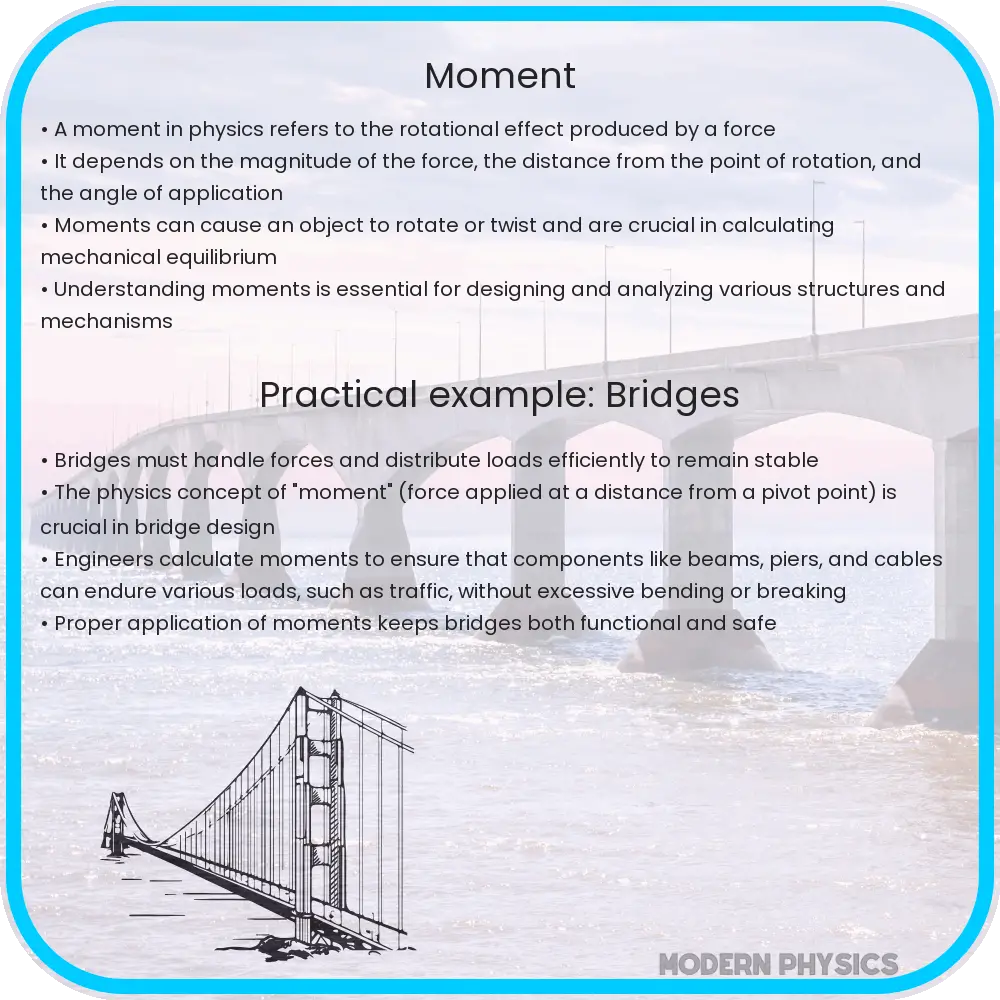Explore the fundamentals of moment and torque in statics, including their application in engineering and physics for structural integrity.

Understanding Moment in Statics: Equilibrium and Torque
In the world of physics, particularly in the study of statics, the concept of moment plays a pivotal role in understanding how forces affect objects at rest. A moment, often referred to as torque, is the measure of the force causing an object to rotate. Understanding this concept is crucial in fields ranging from engineering to architecture, as it helps in designing structures and machinery that can withstand various forces without collapsing or failing.
The Basics of Moment
The moment of a force is a vector quantity that represents the magnitude of the force multiplied by the distance from the point of rotation, commonly known as the lever arm. The mathematical representation of moment (M) is given by:
M = F × d
where F is the force applied and d is the perpendicular distance from the axis of rotation to the line of action of the force.
Equilibrium in Statics
In statics, equilibrium is a state where an object remains at rest or moves with a constant velocity, indicating that the net force and net moment acting on the body are zero. This principle forms the basis of analyzing structures and systems in static equilibrium. The conditions for equilibrium are:
- The sum of all horizontal forces must be zero.
- The sum of all vertical forces must be zero.
- The sum of all moments about any point must be zero.
Mathematically, these conditions are represented as:
∑Fx = 0, ∑Fy = 0, ∑M = 0
Torque and its Applications
Torque, often used interchangeably with moment, is a force that causes an object to rotate about an axis. It is a fundamental concept in many applications, from simple tools like wrenches to complex machines like engines. Torque is crucial in determining how much force is required to rotate an object and is essential in designing mechanical systems.
Understanding torque and its implications is vital in ensuring that structures and machines are not only efficient but also safe and reliable. For instance, in the design of a bridge, calculating the torque exerted by various forces, including the weight of vehicles and environmental factors like wind, is essential for ensuring the bridge’s stability and integrity.
By analyzing the moments and torque acting on a structure, engineers can determine the best materials and designs to use, ensuring that the structure can withstand the forces it will encounter throughout its lifespan.
In summary, moment and torque are fundamental concepts in statics, providing essential insights into how forces affect objects at rest. Understanding these concepts is crucial in the design and analysis of structures and mechanical systems, ensuring their stability, efficiency, and safety.
Calculating Moments and Torque in Real-World Scenarios
Applying the concepts of moments and torque in practical scenarios involves calculations that consider various factors. For instance, in construction, engineers must calculate the moments caused by loads such as the weight of the building materials and the forces exerted by environmental factors like wind and earthquakes. These calculations help in determining the size and type of structural supports needed.
Similarly, in the automotive industry, understanding torque is vital for engine performance. Torque affects how quickly a vehicle can accelerate. Therefore, engineers must design engines that provide enough torque to meet performance requirements while also being efficient and reliable.
Challenges in Analyzing Moments and Torque
One of the challenges in analyzing moments and torque is dealing with complex systems where forces are not easily quantifiable or predictable. In such cases, advanced mathematical models and computer simulations are often used. These tools allow for the analysis of hypothetical scenarios and the testing of various design options without the need for physical prototypes.
Additionally, in dynamic systems where forces change over time, such as in rotating machinery, the analysis becomes more complex. Engineers must consider not only the static moments but also the dynamic effects of motion, such as centrifugal force and gyroscopic effects.
Conclusion
The study of moment and torque in statics is a cornerstone of physics and engineering. It provides crucial insights into the behavior of structures and mechanical systems under various forces. From the stability of towering skyscrapers to the performance of high-speed vehicles, the principles of equilibrium, moments, and torque play a pivotal role.
Understanding these concepts is not only about ensuring structural integrity and mechanical efficiency but also about innovation and pushing the boundaries of what is physically possible. As technology advances, the application of these principles becomes increasingly sophisticated, leading to more innovative and efficient designs in engineering and architecture.
In conclusion, the knowledge of moments and torque is indispensable in the modern world. It empowers engineers and architects to create structures and machines that are not only functional and safe but also groundbreaking in their design and capability.
